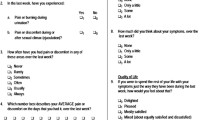Abstract
There is no one unifying etiological mechanism or specific curative therapy for chronic prostatitis/ chronic pelvic pain syndrome (CP/CPPS). However, there is sufficient evidence to suggest that each of the proposed mechanisms may be important in some patients, and that many of our evaluated treatments do in fact work in subgroups of patients. We hypothesize that CP/CPPS patients are not a homogenous group suffering from a single disease entity. Rather, CP/CPPS patients are actually unique individuals with differing clinical phenotypes based on various etiological mechanisms with distinctive symptom complexes and progression trajectories. We call this the “Snow Flake Hypothesis.” We propose the UPOINT (urinary, psychosocial, organ-specific, infection, neurologic/systemic, and tenderness domains) clinical phenotyping classification; we have validated the concept in a CP/CPPS cohort and have suggested that phenotypically directed therapy will improve our clinical treatment outcomes.
Similar content being viewed by others
References and Recommended Reading
McNaughton-Collins M, Joyce GF, Wise M, et al.: Prostatitis. In Urologic Diseases in America. Edited by Litwin MS, Saigal CS. US Dept of Health and Human Services, Public Health Service, National Institutes of Health, National Institute of Diabetes and Digestive and Kidney Diseases. Washington DC: US Government Printing Office; 2007:9–41.
Calhoun EA, McNaughton-Collins M, Pontari MA, et al.: The economic impact of chronic prostatitis. Arch Intern Med 2004, 164:1231–1236.
McNaughton-Collins M, Pontari MA, O’Leary MP, et al.: Quality of life is impaired in men with chronic prostatitis: the Chronic Prostatitis Collaborative Research Network. J Gen Intern Med 2001, 16:656–662.
Shoskes DA, Nickel JC, Rackley RR, Pontari MA: Clinical phenotyping in chronic prostatitis/chronic pelvic pain syndrome and interstitial cystitis: a management strategy for urologic chronic pelvic pain syndromes. Prostate Cancer Prostatic Dis 2009 (in press).
Shoskes DA, Nickel JC, Dolinga R, Prots D: Clinical phenotyping of chronic prostatitis/chronic pelvic pain patients and correlation with symptom severity. Urology 2009, 73:538–543.
Nickel JC: Inflammatory conditions of the male genitourinary tract: prostatitis and related conditions, orchitis, and epididymitis. In Campbell-Walsh Urology, edn 9. Edited by Wein AJ, Kavoussi LR, Novick AC, et al. Philadelphia: Elsevier; 2006:330–370.
Krieger JN, Nyberg L Jr, Nickel JC: NIH consensus definition and classification of prostatitis. JAMA 1999, 282:236–237.
Nickel JC, Nyberg L, Hennenfent M: Research guidelines for chronic prostatitis: a consensus report from the First National Institutes of Health-International Prostatitis Collaborative Network (NIH-IPCN). Urology 1999, 54:229–233.
Litwin MS, McNaughton-Collins M, Fowler FJ Jr, et al.: The National Institutes of Health chronic prostatitis symptom index: development and validation of a new outcome measure. J Urol 1999, 162:369–375.
Nickel JC, Downey J, Clark J, et al.: Levofloxacin for chronic prostatitis/chronic pelvic pain syndrome in men: a randomized placebo-controlled multicenter trial. Urology 2003, 62:614–617.
Alexander RB, Propert KJ, Schaeffer AJ, et al.: Ciprofloxacin or tamsulosin in men with chronic prostatitis/chronic pelvic pain syndrome. Ann Intern Med 2004, 141:581–589.
Nickel JC, Pontari M, Moon T, et al.: A randomized, placebo-controlled, multicenter study to evaluate the safety and efficacy of rofecoxib in the treatment of chronic nonbacterial prostatitis. J Urol 2003, 169:1401–1405.
Nickel JC, Krieger JN, McNaughton-Collins M, et al.: Effect of alfuzosin on symptoms in men with chronic prostatitis/ chronic pelvic pain syndrome. N Engl J Med 2009 (in press).
Nickel JC, Downey J, Pontari MA, et al.: Randomized placebo-controlled, multi-center study to evaluate the safety and efficacy of finasteride in the treatment of male chronic pelvic pain syndrome: category IIIA CPPS (chronic nonbacterial prostatitis). BJU Int 2004, 93:991–995.
Nickel JC, Forrest JB, Tomera K, et al.: Pentosan polysulfate sodium therapy for men with chronic pelvic pain syndrome: a multicenter, randomized, placebo-controlled study. J Urol 2005, 173:1252–1255.
Pontari MA, Krieger J, Litwin MS, et al.: A randomized placebo-controlled multicenter trial of pregabalin for the treatment of men with chronic prostatitis/chronic pelvic pain syndrome [abstract 340]. J Urol 2009, 181(Suppl 4):123.
Nickel JC, Xiang J: Clinical significance of non-traditional uropathogens in the management of chronic prostatitis. J Urol 2008, 179:1391–1395.
Cheah PY, Liong ML, Yuen KH, et al.: Terazosin therapy for chronic prostatitis/chronic pelvic pain syndrome: a randomized, placebo controlled trial. J Urol 2003, 169:592–596.
Mehik A, Alas P, Nickel JC, et al.: Alfuzosin treatment for chronic prostatitis/chronic pelvic pain syndrome: a prospective, randomized, double-blind, placebo-controlled, pilot study. Urol 2003, 62:425–429.
Tugcu V, Tasci AI, Fazlioglu A, et al.: A placebo-controlled comparison of the efficiency of triple- and monotherapy in category III B chronic pelvic pain syndrome (CPPS). Eur Urol 2007, 51:1113–1118.
Nickel JC, Narayan P, McKay J, Doyle C: Treatment of chronic prostatitis/chronic pelvic pain syndrome with tamsulosin: a randomized double-blind trial. J Urol 2004, 171:1594–1597.
Yang G, Wei Q, Li H, et al.: The effect of alpha-adrenergic antagonists in chronic prostatitis/chronic pelvic pain syndrome: a meta-analysis of randomized controlled trials. J Androl 2006, 27:847–852.
Mishra VC, Browne J, Emberton M: Role of alpha-blockers in type iii prostatitis: a systemic review of the literature. J Urol 2007, 177:25–30.
Nickel JC, Shoskes D, Irvine-Bird K: Clinical phenotyping of women with interstitial cystitis/painful bladder syndrome (IC/PBS): a key to classification and potentially improved management. J Urol 2009 (in press).
Nickel JC, Downey J, Ardern D, et al.: Failure of a monotherapy strategy for difficult chronic prostatitis/chronic pelvic pain syndrome. J Urol 2004, 172:551–554.
Shoskes DA, Hakim L, Ghoniem G, Jackson CL: Long-term results of multimodal therapy for chronic prostatitis/ chronic pelvic pain syndrome. J Urol 2003, 169:1406–1410.
Author information
Authors and Affiliations
Corresponding author
Rights and permissions
About this article
Cite this article
Nickel, J.C., Shoskes, D. Phenotypic approach to the Management of chronic prostatitis/chronic pelvic pain syndrome. Curr Urol Rep 10, 307–312 (2009). https://doi.org/10.1007/s11934-009-0050-7
Published:
Issue Date:
DOI: https://doi.org/10.1007/s11934-009-0050-7




